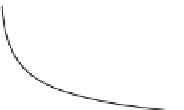Information Technology Reference
In-Depth Information
Fig. 5.10 The learning curve
for a series of better
strategies, showing the initial
slow down and then savings
due to switching strategies
0
200
400
600
800
1000
Trials
This was first noted when cigar rollers improved up to a point and then stopped. It
was found that the users were rolling faster than the machine could pass materials
to them (Snoddy
1926
).
The second place where users do not get faster is when they change strategies.
As a user picks up a new strategy, they will often experience a slowdown, moving
back on the practice curve for that strategy. However, with practice, performance
on this curve with a lower intercept improves, usually to be much better than the
previous strategy (Delaneyet al.
1998
). Figure
5.10
illustrates this effect.
If your system supports multiple learning strategies, you should consider
helping the user transition between them. In text editors, for example, there are
several ways to find a particular text string, including scrolling and searching line-
by-line, scrolling and searching by paragraph, and using the inbuilt search func-
tion. In one survey (Card et al.
1983
), most users were not using the most efficient
strategy (searching), but moving line-by-line. Experts use searching, which can be
100 times faster than scrolling.
5.4.3 Types of Learning
Learning can be described in several ways. It can be organized by the types of
memories that are created or practiced. One common way to distinguish types of
learning is as declarative and procedural. Another common way is as implicit and
explicit. The distinctions between these classifications are still being argued over,
















Search WWH ::

Custom Search